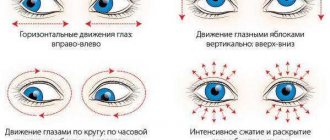A woman may want to give birth wearing lenses for a variety of reasons: for example, she is simply used to them and feels uncomfortable without them, her eyesight is so poor that if the doctor shows her the baby when she is without lenses, she will only see a blurry spot . She doesn't have glasses. She's not used to wearing glasses. She wears contact lenses all the time; taking them off is like being naked.
By and large, doctors should have no objections. If the birth is expected to be easy, the woman in labor is healthy and there is no fear that complications may arise, the lenses will not harm her in any way. The only thing you need to do is take a jar of liquid for the lenses with you, so that if the labor takes a long time or something goes wrong, contrary to expectations, you can safely remove them and put them next to each other.
Childbirth and poor vision
When doctors say that poor vision can affect childbirth, they most often mean myopia (nearsightedness). Myopia is a disorder of visual focus that impairs distance vision. Hence the second name of the disease: myopia, since people with myopia see much better up close. There are three degrees of myopia: up to 3 diopters - weak degree; from 3.25 to 6 diopters - average degree; over 6 diopters - strong degree.
If myopia is weak or moderate, then childbirth will not affect it in any way. But with high myopia, there is a risk that during childbirth, already poor vision will become even worse. Why? During childbirth, a woman’s entire body experiences extreme stress, including her eyes. And with myopia, the retina (a thin layer of nervous tissue located on the inside of the back of the eyeball) is already thinned and stretched, and under heavy stress it can detach or rupture. In this case, vision can deteriorate significantly.
Standard visits
To be honest, it will not be possible to answer all the questions asked at once. The thing is that during pregnancy you have to take the topic of vision very seriously. Consultation with an ophthalmologist is necessary at least 2 times during the period of “interesting situation”.
The first examination, as a rule, occurs at the very beginning of pregnancy, in the first trimester, after the woman is registered at the antenatal clinic or private clinic. Usually the visit takes place 12-14 weeks from the moment of conception. If the expectant mother’s vision is fine, then the next appointment with the ophthalmologist is scheduled for approximately 30 weeks, before or after maternity leave.
But when it turns out that a woman has some kind of eye diseases and problems, she has to be checked monthly by an ophthalmologist. The doctor will have to select a treatment, and then prepare the expectant mother as much as possible for childbirth.
Ophthalmologist during pregnancy
If the expectant mother has visual impairment, then she should visit the ophthalmologist at least 3 times: at the beginning, in the middle and at the end of pregnancy. Why so often? It is necessary to monitor the condition of the retina so as not to miss the moment when some changes or even tears appear on it. And this can only be done by regularly seeing a doctor.
At the end of pregnancy, the ophthalmologist gives an opinion on the state of vision and recommends delivery tactics. If the doctor writes that “it is recommended to exclude the period of pushing due to possible damage to the vessels in the retina,” this means that, most likely, a cesarean section will be necessary. If the condition of the retina is normal, then the ophthalmologist will simply write: “There are no contraindications to natural childbirth.”
In addition, all vision problems should be discussed with the doctor who will deliver the baby. After all, the ophthalmologist only recommends tactics for their management, and the final decision is still up to the obstetrician-gynecologist.
When to see a doctor
Experts recommend visiting an ophthalmologist at least twice - in the first and last trimesters. First, the doctor will evaluate the condition of the eyes and make sure that additional dry eyes have not appeared due to hormonal changes. In this case, the lenses will have to be replaced with glasses for a while. If there are no contraindications, you can use lenses throughout the entire period of pregnancy.
Secondly, the ophthalmologist will definitely check visual acuity and carefully examine the fundus of the eye. If even a minimal risk of retinal detachment during childbirth is detected, the woman will be advised to have a cesarean section. Otherwise, the expectant mother risks her eyesight.
In general, visual acuity may decrease during pregnancy. To minimize possible deterioration, visit an ophthalmologist in the first and last trimesters, and also consult a doctor
every time you notice any changes in the condition of your eyes.
Myopia and caesarean section
Many people believe that the presence of myopia is a direct path exclusively to a caesarean section. But that's not true. There is an instruction from the Ministry of Health and Social Development, compiled jointly by ophthalmologists and obstetricians-gynecologists. According to this document, surgical intervention is necessary only for myopia greater than minus 7 diopters. In other cases, it is proposed to act based on the specific situation.
This means that when deciding how best for a woman to give birth, the doctor will take into account not only visual acuity, but also the general well-being of the expectant mother, her age, the condition of the retina, and various complications during pregnancy. For example, if high blood pressure, edema and other complications are added to myopia (albeit a weak degree), a cesarean section cannot be avoided.
By the way, now many doctors generally believe that visual acuity should not affect the method of childbirth and you can give birth even at minus 10–12, the main thing is that the retina is in good condition.
Positive sides
So is it possible to give birth wearing lenses? In fact yes. But in some cases this is not recommended. What advantages could there be from such a solution? The first and most important thing is that everything that happens will be clear to the mother. Especially if the woman in labor has poor vision, but the eyes themselves are in perfect condition. The mother will be able to get a good look at the baby in the first minutes of his life.
Next is the protection of the eyes from the vacuum that forms during the period of pushing in the eye and eyelid area. It is harmful to health. This causes blood vessels to appear in the eyes (red). And lenses protect the cornea to some extent.
After all, to have a good birth, a woman must feel comfortable. And if she needs lenses for this, she has the right to use them. After all, in fact, not a single ophthalmologist will give clear recommendations regarding the question posed.
Natural childbirth and the condition of the retina
If natural childbirth is allowed, then the most important thing during it is to push correctly. What does it mean? It is necessary to push exclusively in the place from which the child emerges. That is, you don’t need to strain your face or close your eyes - it won’t do any good. All effort should go to the perineum. It is the pelvic floor muscles, together with the abdominal muscles, that will help the baby be born.
If you strain your face (push with your face), then the child will not get any help, and your strength will be wasted, and your eyes may suffer. Unnecessary strain will cause intraocular pressure to increase, which can cause small blood vessels to burst. With a normal eye condition or with slight myopia, this is not a problem, but with a strong degree of it, bleeding, rupture may occur in the retina, and in the worst case, it will begin to peel off.
In fact, with myopia, retinal pathology is not always present. Even with a high degree of myopia, the condition of the retina can be good. Conversely, changes in the retina can also occur in a person with normal vision.
Red eyes - is it worth the risk?
Sometimes women have red blood vessels in their eyes. Is it worth using contact lenses in such a situation? Doctors recommend first finding out why the redness appeared. If this is a consequence of overexertion or illness, you should not wear lenses.
When it comes to redness caused, for example, by dirt or dust getting into the eye area, there are no prohibitions. Again, remember that it is okay to wear contacts during labor. But for an accurate answer, an appointment with an ophthalmologist is required. This is an individual issue, the solution of which requires a thorough examination of the condition of the eyes.
Childbirth, glasses and contacts
Is it possible to give birth with glasses? Is it possible to take them to the birth block? Of course you can, because without glasses many people feel extremely uncomfortable.
But is it possible to give birth in lenses? Even ophthalmologists do not have a clear answer to this question. On the one hand, there is nothing wrong with wearing lenses during childbirth, because they do sports in the lenses and even sleep in them. But everyone’s lenses are different, and women feel differently in them too. Someone can wear lenses for only one day and must take them off in the evening. Others wear lenses for a month and feel great with them. Therefore, it is necessary to decide, taking into account each specific situation.
Why is it often recommended to remove lenses during childbirth? If a woman pushes incorrectly, the lenses can further aggravate the eye condition. In addition, if any emergency intervention with anesthesia is required, then the lenses will definitely need to be removed. Where should we put them in the birth block? Therefore, if you want to give birth wearing lenses, you need to take a special solution and a container for storing lenses with you to the maternity hospital. And be sure to warn doctors that you are giving birth with lenses.
Is it possible to give birth wearing contact lenses?
All women carrying a child are required to visit an ophthalmologist at least twice during pregnancy - in the first weeks and at the end of the term, immediately before the birth itself. This is explained quite simply: during pregnancy, hormonal levels in the body are disrupted, which can cause vision impairment. Moreover, in some cases, retinal detachment is even observed.
An examination means a standard vision test, but with a mandatory examination of the fundus. If everything goes well, the next examination will be scheduled about a month before the planned birth. But if changes are detected in the retina, then, accordingly, you will be prescribed treatment. In this case, the pregnant woman will have to go to the doctor every month.
Pregnant women should be checked by an ophthalmologist at least twice during pregnancy
I would also add that the birth of a child itself can be divided into several stages:
- first 12 hours – the birth canal opens;
- 30-40 minutes of pushing - actually, birth;
- another 10-15 minutes for the placenta to pass.
In stages No. 1 and No. 3, wearing contact lenses will not affect labor in any way. For this reason, it is possible to give birth wearing lenses, as there can be no complications.
As for the second stage, if it is contraindicated by doctors due to poor vision, then the woman will not have to give birth wearing contact lenses or glasses, since neither will be required. With anesthesia (mainly local), when a “caesarean section” is performed, the problem of vision correction will disappear by itself.
Attention! In short, you can give birth wearing lenses - this is more beneficial than harmful, but only if you do not have any eye diseases . But if such diseases do occur, then childbirth in lenses should be taken responsibly and fully follow the recommendations of ophthalmologists.
But what is the benefit of wearing corrective devices during childbirth, you ask? There is a benefit, because during strong pushing not only the abdominal muscles are tense, but also the eyes. A vacuum cushion is formed between the cornea and the lens, which can cause micro-ruptures of the capillaries and, as a result, hemorrhage into the sclera. And if at this time the eye is covered with a contact lens, then a vacuum is not created. In this case, the woman’s eyes do not become inflamed or red.
Lenses during childbirth can prevent the appearance of a vacuum cushion between the cornea and the lens and, as a result, hemorrhage into the sclera
Find out detailed information about why you should not give birth with poor vision from a new article on our portal.
Improved vision after childbirth? It's possible
There are women whose vision after childbirth not only does not deteriorate, but even improves. This happens because vision problems arose as a result of certain disorders in the body - muscle spasms, pinched nerves, congestion. During the birth process, these problems disappear, and as a result, the young mother begins to see everything in a truly new light.
Doctors' attitude towards childbirth among women with vision problems has now changed. People give birth naturally and with high myopia, and after some eye surgeries. If you have any doubts, go to a large ophthalmology clinic; they will definitely know which method of childbirth is best to choose in which situation.
Acceptance of childbirth
Childbirth is divided into three stages:
- preparation for childbirth up to the opening of the birth canal;
- time of childbirth, the head comes out, then the rest of the child’s body;
- passing of the placenta.
If a woman has no eye health problems, lenses can be worn at all stages of childbirth. They will not interfere if the process proceeds naturally. If a cesarean section is scheduled, the lenses will be removed before surgery. If there is no container, the pair is thrown away.
If women have moderate to severe myopia, it is possible to wear lenses in the first trimester. At the beginning of the second, it is better to remove them to prevent eye damage. The best option in this case is to completely replace the lenses with glasses. This is due to the fact that the patient will not have time to remove the pair in time before the second stage of labor begins.
If a woman has retinal detachment, natural childbirth is contraindicated. A caesarean section is prescribed, which is performed without lenses or glasses. The surgical option completely eliminates the retinal tear option.
Three stages
There is another opinion. The entire period of childbirth can be divided into several parts:
- preparation and dilation of the cervix (approximately the first 12 hours);
- labor, pushing (about 30-40 minutes);
- rest, “departure” from childbirth (15 minutes or more).
You can wear lenses during the first and last periods. But during the period of active labor, many are advised to refrain from this action. Although everything is individual. If the retina and cornea are in normal condition, you can use lenses. Especially if it is needed for convenience and comfort. Otherwise, it is better to refrain from giving birth while wearing lenses. There are no direct prohibitions, but sometimes it is better to clarify this issue with an ophthalmologist.











